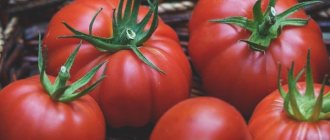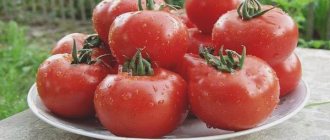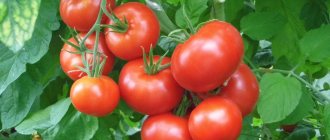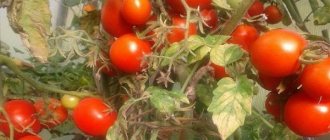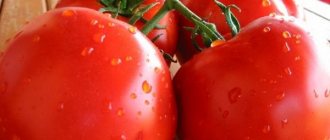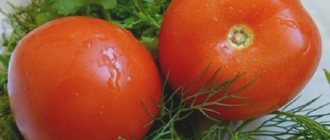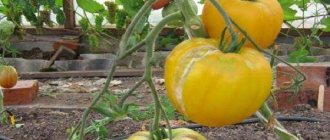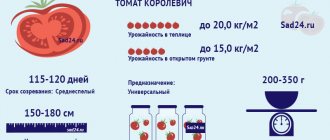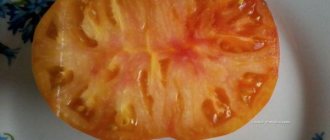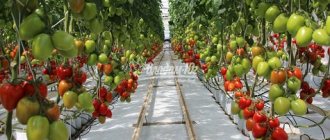Tomato Werner f1: variety description
One of the most popular crops adapted to growing in the Russian climate is tomatoes. Tomatoes grown with your own hands are much more juicy and natural than those sold in markets and stores. The description of the Werner f1 tomato says that the fruits are juicy, sweet, large and at the same time the fruits ripen quickly.
Of course, it is very important that this variety is suitable for growing in open ground. Not everyone has a spacious greenhouse at their dacha, and even it does not always have the temperature necessary for ripening
The first advantage is stability and unpretentiousness to weather conditions. What is important is that, regardless of the temperature conditions, the yield is always high, since this species is designed specifically for planting in open space.
The tomato variety Werner f1 is a leader in many respects, as it has excellent taste and almost one hundred percent yield.
Before planting in the ground
Tomato fruits take up to 90 days to ripen, so planting in early to mid-May is recommended to allow the harvest to ripen by the end of July. However, no matter how unpretentious the vegetable is to the weather, the seeds will not germinate in frozen ground. So experienced gardeners have long been accustomed to planting seeds in pots on windowsills at home in May.
At home, the sprouts will sprout much faster, and the stems will be much stronger. It is recommended to plant tomatoes in the soil not immediately after the sprouts appear, but first to take them out onto the balcony or into a colder room so that the plant gets used to it.
What to do after sprouts appear?
Tomato Werner f1, like other varieties, should be watered abundantly only after the first leaves appear. And the already strong sprouts can be planted in the soil closer to mid-June.
During planting, it is better to do pruning, that is, slightly trim the roots of the plant to improve their growth.
A distance of half a meter should be left between seedlings so that the root systems of neighboring bushes do not interfere with each other.
The sprouts should be carefully looked after for a week after planting so that they become stronger. Apart from the time after planting in open ground, the shoots are not afraid of the sun, cold and wind. Dutch producers made sure that with minimal care this variety produces a rich harvest. And as experience has proven, Werner tomatoes are successfully grown in the far north of Russia.
So, let's repeat the action plan:
- plant seeds in a pot;
- when sprouts appear, we take the pots out onto the balcony;
- We begin abundant watering after the leaves appear;
- we plant the strengthened sprouts in the soil;
- we take care for a week after planting;
- We are waiting for the result.
What are buyers saying?
According to reviews from customers who have already tried to grow Werner tomatoes, the bushes are literally covered with large fruits. And the description of taste qualities in fact does not differ from what advertisers say.
The tomatoes do not crack, the taste remains rich and juicy. Although the fruits ripen quite quickly, if necessary, they ripen in a cut state in a couple of days without any extra effort. This variety is used both raw and for preparing salads, sauces and other dishes.
Availability
Werner f1 tomato seeds are freely sold in most seed stores in Russia. And growing tomatoes is permissible not only in open spaces; they also bear fruit well at home.
For example, if you don’t have a summer house or the opportunity to travel outside the city, you can plant the seeds in a flower pot and harvest them in a couple of months. This method of growing is quite convenient, since the bush is short and does not take up much space.
Before planting in the ground
Tomato fruits take up to 90 days to ripen, so planting in early to mid-May is recommended to allow the harvest to ripen by the end of July. However, no matter how unpretentious the vegetable is to the weather, the seeds will not germinate in frozen ground. So experienced gardeners have long been accustomed to planting seeds in pots on windowsills at home in May.
At home, the sprouts will sprout much faster, and the stems will be much stronger. It is recommended to plant tomatoes in the soil not immediately after the sprouts appear, but first to take them out onto the balcony or into a colder room so that the plant gets used to it.
Characteristic
Tomato 33 Bogatyr belongs to the nightshade family. This variety is characterized by medium ripeness - appetizing tomatoes appear on the bushes three and a half months after sowing the seeds. Suitable for growing in greenhouse conditions, as well as in open ground.
The plant is determinate, that is, medium-sized. The bush grows on average up to one and a half meters in height, does not fall apart, but requires support. It is unpretentious in cultivation and care, tolerates heat and the effects of various diseases well. With proper care it produces an excellent harvest. From one square meter you can harvest up to 7 kilograms of tomatoes, in a greenhouse - 10-11 kilograms. Gives more yield when formed into two stems.
Fact: 33 Bogatyrs are suitable for cultivation in any climatic conditions, which is why this variety is very common in all latitudes.
The fruits of this variety grow large and cube-shaped. The average weight of one tomato is 400-450 grams. The peel is smooth, red. The pulp is fleshy, loose, very tasty. Tomatoes of this variety are well suited for fresh consumption and the preparation of tomato juice and paste. However, for canning it is better to choose other varieties with smaller fruits.
The plant stops growing when 2 to 6 clusters are formed on the stem. The top of the plant is the last tassel that has grown. The bush continues to grow from the stepsons located on the lower leaves.
Features of the variety:
- 33 bogatyrya refers to the varieties that ripen earlier than others;
- compact bushes, requires one garter;
- the fruits ripen together;
- the plant forms many stepsons, which help increase the yield.
- good yield compared to other determinate varieties;
- need to be constantly fed with mineral fertilizers;
- With each new wave, the fruits become smaller in size.
Description of tomato Verige F1, growing seedlings of a hybrid variety
Various varieties of cherry tomatoes are very popular among vegetable growers. The Verige F1 tomato has good reviews; the description and height of the bush, its characteristics and care features are indicated on the package with the seeds.
The manufacturer indicates that this nightshade hybrid is an unpretentious and hardy variety, and also has good immunity to disease. Even a novice gardener can grow miniature, tasty tomatoes. But before you start growing, it’s still worth studying the features of the Verige variety and recommendations for its cultivation.
Main characteristics
Tomato variety Verige F1 belongs to the determinate species. The plant has a small and compact appearance. It reaches a height of no more than 1 m. The strong and powerful trunk does not need additional support; its branches are not spreading, slightly directed upwards. The foliage has a regular shape and is dark green in color. It sparsely fills the entire plant.
The Verige variety belongs to the early ripening species. The first fruits can be harvested 85-90 days after the first sprouting of seedlings. The tomato is suitable for growing in open ground and in greenhouse conditions.
The first ovary of the raceme is formed after 6-7 leaves. On average there are from 8 to 12 tomatoes on one brush. The small fruits have a round and slightly elongated shape, are bright red in color, and two-chambered. The average weight of one tomato is about 20-25 g. The peel of tomatoes is dense, smooth and shiny. Thanks to its properties, the fruits are protected from cracking.
Tomatoes ripen on bunches at the same time, which greatly simplifies the harvesting process. Sometimes gardeners prefer to harvest by picking the whole cluster at once. In this form, Verige tomatoes can be stored for a long time. The shelf life of the crop is quite long: from 2 to 4 weeks. The yield of the Verige variety is high; from 1 m² you can harvest from 5 to 7 kg. Hard and dense cherry tomato fruits withstand long-term transportation.
The taste of these tomatoes is excellent. They have juicy and dense pulp, a pronounced tomato taste with a slight sourness. Verige tomatoes have a sugary flavor with fruity notes. The fruits are suitable for universal use. You can use them to make fresh salads, juice, pasta and canned whole.
The Verige tomato variety tolerates drought and heat well. Its dense peel reliably protects the fruit from sunlight, and its powerful root system fully nourishes the bush.
Growing seedlings
Seeds are planted for seedlings in the second half of March. First you need to prepare the seeds for planting. To do this, perform the following steps:
- The planting material is soaked in a weak solution of manganese for 30 minutes, after which the seeds are laid out on a clean sheet of paper and left on the windowsill until completely dry. Manganese allows the seeds to be further protected from fungi and some diseases.
- A growth stimulator solution will speed up the germination process of tomatoes. The seeds are soaked in it for half an hour. Then dry naturally.
Sowing of seeds is carried out in a special container with soil. The soil can be purchased ready-made in the store or you can prepare it yourself. To do this, mix turf soil, peat and sand in equal parts. The soil is well moistened and fluffed up. The seeds are buried 1-1.5 cm into the soil and covered with earth on top.
As soon as the first 2 leaves appear on the sprouts, begin picking. You can plant seedlings in larger containers or use plastic or peat cups for this.
Description and characteristics of the variety
Tomato Verna is a semi-determinate tall variety with stems up to 1.5 m long. The shoots are spreading, with moderate foliage.
The ripening period is average - 110-115 days from germination. The average fruit weight varies from 180 to 220 g. Tomatoes have a plum shape, a bright orange color, and resemble suns. Ideal for preservation as a whole.
The taste is sweetish with a subtle tomato sourness. Orange tomatoes are included in the diets and dietary tables of patients with gastrointestinal problems. Recommended for baby nutrition.
A high-yielding variety produces 25 kg per 1 m2 in favorable greenhouse conditions, in some cases the yield reaches 40 kg per 1 m2. From 1 plant they remove from 5 to 9 kg.
Hybrid tomato Werner was bred by Dutch breeders. It is suitable for open ground. But it is also successfully grown in film greenhouses. This is an early ripening beef tomato. It bears fruit well even in northern regions.
This hybrid type of tomato has an optimal combination of plant power with early ripening and the formation of relatively large fruits. The height of the bushes is no more than 70 cm (a determinate type of tomato), they have little foliage.
Tomato ripening occurs approximately 90 days after the appearance of the first shoots. The weight of one Werner tomato can reach 240–280 g, and in some cases - 300 g. Weather conditions have only a slight negative impact on the quantity and quality of the ovary formed.
The fruits have a rich pink color, and the taste is quite high. On a 10-point scale, this hybrid has 9 points. They do not contain the usual acid inherent in many representatives of this type of vegetable. The sugar structure of the fruit is most organically suitable for eating Werner tomatoes fresh, for adding to salads, as well as for making juices, pastes or ketchup.
Tomatoes have a flat-round shape. On top they are covered with a rather dense skin. This circumstance prevents it from cracking under unfavorable irrigation conditions (insufficient or too abundant irrigation). As reviews note, the plant is highly resistant to disease.
Landing rules
Tomato seeds are sown in containers for growing seedlings no earlier than March. Before sowing, seeds must be treated with special means and then disinfected. For this purpose, a weak solution of manganese is used. The seeds are dipped in a slightly warm liquid for a quarter of an hour, and then placed in a solution of Epin for 12 hours, having previously studied its description. Seeds prepared in this way are planted in containers with soil.
What to do after sprouts appear?
Tomato Werner f1, like other varieties, should be watered abundantly only after the first leaves appear. And the already strong sprouts can be planted in the soil closer to mid-June.
During planting, it is better to do pruning, that is, slightly trim the roots of the plant to improve their growth.
A distance of half a meter should be left between seedlings so that the root systems of neighboring bushes do not interfere with each other.
The sprouts should be carefully looked after for a week after planting so that they become stronger. Apart from the time after planting in open ground, the shoots are not afraid of the sun, cold and wind. Dutch producers made sure that with minimal care this variety produces a rich harvest. And as experience has proven, Werner tomatoes are successfully grown in the far north of Russia.
So, let's repeat the action plan:
- plant seeds in a pot;
- when sprouts appear, we take the pots out onto the balcony;
- We begin abundant watering after the leaves appear;
- we plant the strengthened sprouts in the soil;
- we take care for a week after planting;
- We are waiting for the result.
What are buyers saying?
According to reviews from customers who have already tried to grow Werner tomatoes, the bushes are literally covered with large fruits. And the description of taste qualities in fact does not differ from what advertisers say.
The tomatoes do not crack, the taste remains rich and juicy. Although the fruits ripen quite quickly, if necessary, they ripen in a cut state in a couple of days without any extra effort. This variety is used both raw and for preparing salads, sauces and other dishes.
Characteristics of the variety
From the moment the first shoots form until the gardener can pick several ripe fruits from the bush, at least 90 days pass. In some cases, the growing season lasts 105–110 days. On the other hand, it is possible to shorten the ripening period. Experienced gardeners can do this easily. The Ogorodnik tomato is characterized by determinate bushes that are compact. However, this variety can exhibit the characteristics of a tall plant, reaching a height of 1.20 cm. There are tomato plants up to 60 cm long, they are decorated with light green leaves.
The culture develops successfully in open ground, and the plant in a greenhouse or hotbed demonstrates excellent growth and fruit formation. This is the best variety for farmers who do not want to waste time on pruning the bush. It is advisable to tie up even compact low bushes due to the large number of fruits that are borne on the plant’s numerous clusters.
Advice! People who have chosen the Ogorodnik tomato variety for commercial purposes are advised to form a pair of stems, which will allow them to harvest several times more tomatoes than with the usual cultivation of a single stem crop.
The crop bears fruit in ideal weather conditions, with balanced care. In this case, farmers will be able to collect 10-15 kg of fruit per square meter.
The plant produces fruits not only in large quantities, but also for a long time. After the first wave of maturation, the next one comes. There are fewer tomatoes each time, but overall, the overall yield level is impressive. The crop will stop forming ovaries as soon as the first cold snap appears. The crop bears better fruit in the south, but this does not mean that it is impossible to achieve success with cultivation in open ground, say, in the middle zone. Much in terms of yield depends on the farmer.
The fruits are characterized by the presence of a glossy, beautiful skin. These are round, neat tomatoes with a rich red tint. Sweet and sour notes are noticeable in the taste, the latter are not so pronounced. Tomatoes have a pleasant aroma, which allows you to make excellent juice from the fruit.
The tomatoes are dense and meaty. In tomatoes of the Ogorodnik variety, taking into account the characteristics, reviews and descriptions, there is an average number of chambers and a few seeds that can be collected for use as planting material. The average weight of a tomato is 200-350 g.
Early tomatoes are suitable for gardeners who want to grow good fruits in large quantities for sale. More and more farmers are choosing the Ogorodnik variety because of the ability of the bushes to bear large and beautiful fruits that do not spoil during transportation. The density and reliability of the skin guarantee the safety of the tomatoes. Tomatoes contain up to 5% dry matter, and the sugar content is 4%. The keeping quality is amazing, and the versatility of the fruit becomes another factor that can convince anyone to choose a variety for growing on their site.
Seed calibration and treatment
First of all, tomato seeds are calibrated by selecting obviously spoiled grains. Immersing the seeds in a 5% solution of table salt will help select empty grains, which after 5-7 minutes will remain on the surface, while high-quality seed material will settle to the bottom.
Seeds are treated with fungicides. For these purposes, you can use the same fungicides that were indicated above for treating containers for seedlings - all of them are suitable for tomatoes. Solutions are prepared in the proportions specified in the instructions for a particular drug. At the same time, the fungicide is diluted in warm water and the seeds are immersed in the resulting solution for about 20 minutes. After processing, the seed is dried.
In addition, tomato seeds are treated with stimulants to accelerate growth and germination. Such drugs as Biostim, Radifarm, Kornevin, Epin are suitable for this purpose. Solutions are also prepared strictly according to the instructions of the preparations, after which the seeds are soaked in them for up to 6 hours, placing them in a gauze pocket.
Important! After treatment with growth stimulants, the seeds are not washed, but only dried to a free-flowing state.
Advantages and disadvantages of the variety
The Gardener's Delight variety lives up to its name. The following important advantages are noted:
- fruiting is long-lasting, and harvesting can occur throughout the entire season, subject to the basic rules of agricultural technology;
- there is a high level of productivity, because from one bush it is possible to obtain up to 7 kilograms of fruit;
- increased resistance to diseases and parasites, as a result of which unnecessary risks can be eliminated;
- friendly ascension of sprouts, thanks to which tomatoes can be produced almost simultaneously for a long time;
- optimal taste characteristics that can be appreciated even by gourmets.
The above advantages determine the high level of popularity of tomatoes of the Gardener's Delight variety. However, some disadvantages also exist:
- difficulties when planting in the ground, since the seed material must be worked correctly;
- difficulty in forming tomato bushes and processing stepsons;
- the need for the mandatory formation of several stems of a tomato bush with further monitoring of their condition.
Despite the shortcomings, many farmers are ready to appreciate the Gardener’s Delight tomato variety.
Tomato Fidelity F1: photo, hybrid features
| Ripening period: | 90-105 days, (early ripening) |
| Shape, weight of fruits: | round, 130-200 g |
| Bush height: | up to 1.3 m |
| Productivity: | 14-19 kg per 1 m² |
| Growing regions: | southern, with a warm climate (+18 - +25 degrees). In the northern regions it is grown in greenhouses |
Tomato Fidelity F1 is distinguished by excellent taste, large size, early ripeness, and high yield. The variety belongs to the determinant type. Despite its short stature, it requires a mandatory garter. Tomatoes are suitable for canning, making tomato juice, and pickles.
An important advantage of the Vernost variety is its unpretentiousness when grown.
Description and characteristics of the variety
The height of the Vernost tomato bush is 1.3 m. The plant with powerful stems and rhizomes has dark green smooth leaves and white flowers. The shape of the inflorescences resembles bunches of grapes with large fruits weighing 130-200 g. Tomatoes have a round shape with flattened “poles”.
The early-ripening hybrid is characterized by good transportability, which is ensured by the dense skin of tomatoes, which is resistant to cracking.
The fruits have a rich red color and a sweetish taste. Their interior is divided into several chambers, each of which consists of dense, fleshy and juicy pulp.
Under favorable conditions and following the correct growing technology, up to 19 kg of tomatoes per season can be harvested from 1 m².
From the moment the first shoots appear until the fruits fully ripen, 90-105 days pass.
The culture is intended for cultivation in open or closed ground. It is light-loving and grows poorly in shaded areas.
Sowing seeds and growing
Seeds are planted for seedlings in mid-March - early April. It is not recommended to sow earlier than the specified dates for several reasons:
- Daylight hours are shorter in February. Due to lack of light, the seedlings will begin to stretch out and become pale and thin. As a result, after planting in open ground, the plants will need time to gain strength and acquire a normal shape. As a result, the fruits of such seedlings may ripen later than when planted in the second half of March. You shouldn’t keep a lamp on around the clock over your tomatoes, trying to extend daylight hours - some important biological processes can only take place in the dark.
- The optimal age for planting tomato seedlings in the ground is 50-60 days after emergence. Seeds sown during the recommended period will grow by mid-May - early June. It is at this time that the weather is favorable for planting seedlings. Plants sown a month earlier than the optimal time will have outgrown by the time they move to the garden bed, which will negatively affect their health, quality and quantity of ovaries.
Tomato Verna
| Ripening time | mid-season variety |
| Fruit colors | orange-orange |
| Growing method | for growing in a greenhouse |
The Verna tomato variety came to us from sunny Bulgaria. Therefore, it is not worthwhile to grow it in open ground; it is better to immediately plant it under film or in a stationary greenhouse. The plant is semi-determinate, not too tall. It can grow up to one and a half meters, but is usually limited to 1.2 m in height.
The bush is quite spreading and requires tying to a support and pinching. It is also necessary to form the plant into two or three stems.
Due to their composition, these tomatoes are recommended for dietary nutrition and nutrition for children. Plus, in addition to all the advantages, the fruits of the Verna variety are stored well and for a long time. They can be eaten fresh, preserved in any way, including freezing.
And the most important advantage of the variety, which makes it the favorite of all summer residents, is the yield of 10 kilograms per bush. Since four plants can be placed on a square meter of soil, 40 kilograms of the finest quality tomatoes can easily be harvested from one meter.
Sowing seeds for growing seedlings begins 55-60 days before planting. Tomatoes ripen within 110-115 days after germination.
{amp}gt;Tomato Verna (Bulgaria)
photo by Valentina Redko
Availability
Werner f1 tomato seeds are freely sold in most seed stores in Russia. And growing tomatoes is permissible not only in open spaces; they also bear fruit well at home.
For example, if you don’t have a summer house or the opportunity to travel outside the city, you can plant the seeds in a flower pot and harvest them in a couple of months. This method of growing is quite convenient, since the bush is short and does not take up much space.
- Author: Maria Sukhorukikh
Rate this article:
- 5
- 4
- 3
- 2
- 1
(0 votes, average: 0 out of 5)
Share with your friends!
Planting in the ground and caring for tomatoes
When the seedlings grow up and a stable warm temperature is established outside, Vernost tomatoes are planted in open ground.
It is first recommended to harden off young plants that grew on a windowsill or in a greenhouse. To do this, boxes with seedlings are taken outside during the week before planting.
The first day they are left in the fresh air for 20-30 minutes, and in subsequent days the hardening time is gradually increased. This procedure must be carried out to increase the resistance of plants to low temperatures, which often occur in spring.
Although the Vernost variety is not picky about soil quality, it is still recommended to plant tomatoes in slightly acidic or neutral soil fertilized with humus. This will allow you to grow strong, healthy bushes and get a good harvest.
The distance between rows should be 70 cm, between bushes - 40. Seedlings are planted in a checkerboard pattern, two seedlings in one hole and immediately filled with plenty of water.
When planting more than 400-500 bushes, it is advisable to make trenches along the entire length of the row rather than holes around each plant. This will save time when watering tomatoes with a hose in the future.
In dense plantings with a large number of weeds, various diseases and pests often develop. Therefore, every 2-3 weeks it is necessary to clear the beds of weeds, preventing them from growing.
When the height of the bushes reaches 50-60 cm, they need to be tied to supports.
Feeding
A week after planting the hybrid variety Vernost in the ground, the bushes begin to be fed. For this purpose, nitrogen fertilizers are used, which promote the growth of stems and green mass. An excess of nitrogen can cause underdevelopment of flower clusters, so preparations containing this substance must be applied strictly according to the instructions on the package.
In addition to nitrogen, young plants need potassium and phosphorus supplements. Sulfur, calcium, and manganese are also useful for tomatoes. Mineral fertilizers improve plant growth and the taste characteristics of fruits, increase their resistance to diseases and pests, and prevent the occurrence of fungal and viral diseases.
The following fertilizers are used for Vernost tomatoes:
- Chicken droppings.
- Mullein.
- Urea.
- Ammonium nitrate.
- Ammophos.
- Ash.
- Superphosphate.
- Colloidal sulfur.
- Calimagnesia and others.
For convenience, you can use complex fertilizers - Kemira Plus, Mortar, Universal, Nitroammofoska. The plants are fed until the fruits begin to ripen.
It is also recommended to add a solution with a nutrient mixture to the hole when planting seedlings.
Planting in open ground
The best time for transplanting into stationary beds is after 50-60 days. Plant 3-4 plants per 1 m2. Care includes fertilizing during the growing season, flowering and ripening.
For fertilizing, use manure and humus diluted 1:10. Complex preparations “Agricol” and “Solution” provide a quick effect.
Mid-season / Tall
User rating: 5/5
Mid-season / Tall
User rating: 4/5
Mid-season / Tall
Temperature is of no small importance when growing seedlings:
- Containers with planted seeds are left in a room with a temperature of 23–24 ⁰C.
- After germination, the container with the plants is brought into a room where the temperature is from 20 to 23 degrees.
At this time, the plant will benefit from diffused sunlight. Direct rays can burn tender shoots.
By the time of planting in open beds, the plant must be at least 2 months old. The distance between plants in a row is 50 cm, and the row spacing is from 70 cm to 1 meter. To protect plants from fungal infections, the soil in the garden bed is pre-treated with a solution of copper oxychloride (1 tbsp per bucket of water).
“Ox Heart” tomatoes are planted in fertile, light soil. Seeds need to be sown in early March. The depth of the hole should be 2-3 centimeters. Diving is done when the first pair of true leaves appear. When planting, you should maintain 3-4 bushes per square meter. Seedlings need to be fed 2-3 times with complex fertilizer.
After planting, seedlings may “get sick” or even die. To prevent this, it needs to be hardened. 7-10 days before planting, the seedlings are taken to a cooler place for several hours a day. Beds for planting should be formed 5-7 days in advance. The planting depth should not exceed 20-25 centimeters, since the soil temperature at depth is much lower.
READ MORE: Soviet draft horse - a draft horse breed
https://www.youtube.com/watch?v=subscribe_widget
The passage between the ridges is left 70-80 centimeters. Please note that the plant will be very large! Planting of seedlings occurs at the age of 55 to 70 days. Know that the soil temperature during planting should be at least 8 degrees, and ideally 15 degrees. Air temperature - 20-25 degrees. “Ox Heart” tomatoes are planted in unheated greenhouses in May, and in heated ones at the end of April.
The plant should have two lashes - the main trunk and the largest stepson. The remaining shoots should be carefully pinched. It is important not to let them grow. The lower leaves are also removed and the plant is tied to a trellis. Usually 6-8 brushes with ovaries are left.
Feeding is carried out 2-3 times during the entire growth period in the greenhouse. The soil is loosened throughout the entire growing season. But your efforts will be worth it - you will get a fragrant and tender ox heart tomato. Gourmet reviews of the fresh salad with these tomatoes are only positive
Watering plants should be done regularly, 2-3 times a week. It is better to do this in the evening (or morning). You should not water during the day. The water should be warm and settled. For convenience, place a dark container for water next to the garden bed.
Tomato fruits take up to 90 days to ripen, so planting in early to mid-May is recommended to allow the harvest to ripen by the end of July. However, no matter how unpretentious the vegetable is to the weather, the seeds will not germinate in frozen ground. So experienced gardeners have long been accustomed to planting seeds in pots on windowsills at home in May.
At home, the sprouts will sprout much faster, and the stems will be much stronger. It is recommended to plant tomatoes in the soil not immediately after the sprouts appear, but first to take them out onto the balcony or into a colder room so that the plant gets used to it.
Growing rules
In order for the Favorite Holiday tomato to actively grow, develop, and bring abundant harvests without causing trouble for amateur gardeners, it is necessary to adhere to certain rules for planting and caring for this crop.
Planting seedlings
Before planting tomatoes in a permanent place, it is necessary to grow seedlings. Seeds of this variety are usually sown in the first weeks of spring.
Before planting the planting material for seedlings, it must be soaked in special growth stimulants. This is necessary in order to increase the chances of germination. If the seeds were purchased in a store, they do not need to be disinfected. However, homemade planting material should be treated with a manganese solution.
The soil for growing seedlings should be loose and light in structure. If there is no purchased land, you can use garden soil by mixing it with substances such as peat, humus and river sand.
The soil must be placed in a plastic or wooden container. You need to dig small holes in it, 2 cm deep, put the seeds there and bury them. The planting surface should be sprinkled with dry soil.
To moisten tomato seedlings on your favorite holiday using a spray bottle. The liquid must be settled and at room temperature.
During the development of seedlings, the container should be covered with polyethylene material and placed in a dark place. When the first shoots appear, it should be moved to a more illuminated space with a temperature of approximately 18°C. Tomatoes need to be picked when a couple of leaves appear on the sprouts.
Tomato transplant
It is necessary to plant Favorite Holiday seedlings in a greenhouse around mid-May, in open ground - at the end of May. There should be at least 0.3 m between the recesses for planting young plants. If they are planted even more densely, the yield may decrease.
Before planting sprouts in the soil, it must be enriched with humus and filled with plenty of water. When the soil becomes moist and slightly dry, you can dig small holes. One tablespoon of a mixture of superphosphate and calcium sulfate should be placed in the recess.
After planting the seedlings in the ground, it must be watered with a large amount of settled liquid.
Growing and care
One of the most popular crops adapted for cultivation in the Russian climate is tomatoes. Tomatoes grown with your own hands are much more juicy and natural than those sold in markets and stores. The description of the Werner f1 tomato says that the fruits are juicy, sweet, large and at the same time the fruits ripen quickly.
Of course, it is very important that this variety is suitable for growing in open ground. Not everyone has a spacious greenhouse at their dacha, and even it does not always have the temperature necessary for ripening. The first advantage is stability and unpretentiousness to weather conditions. What is important is that, regardless of the temperature conditions, the yield is always high, since this species is designed specifically for planting in open space.
The tomato variety Werner f1 is a leader in many respects, as it has excellent taste and almost one hundred percent yield.
Sowing the seeds of this variety of tomatoes for seedlings is carried out 60-65 days before the intended planting in the ground. When planting seedlings in a permanent place per 1 sq. up to 4 plants are placed per meter of plot.
This is a natural variety of tomato. Therefore, we recommend taking seeds from a ripe fruit and growing them again next season!
If you grew Verna tomatoes, please write whether you liked them or not. What was the yield and taste of the fruit? If possible, attach a photo of the fruit or the entire bush. Thank you!
READ MORE: Growing perennials from seeds
Your reviews of the Verna tomato and additions to the description will help many gardeners evaluate this variety more objectively and decide whether it is worth growing or not.
For seedlings, seeds are prepared and sown in early March. Treat in advance for 12 hours with Kornevin. Sow in fertile soil to a depth of 1.5 cm. Compact and water. Cover the container with film and place it in the light in a warm place at a temperature of 22-24 degrees.
To grow strong seedlings:
- feed once every 10 days with “Kemira-universal”;
- hardened at 15 degrees for 1 week;
- dive into 0.5 liter pots with 2 true leaves.
Ripe tomatoes are stored well in dark, cool rooms for up to 3 weeks.
